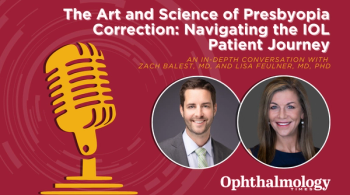
Ophthalmic bevacizumab deemed effective for treatment of wet macular degeneration in NORSE TWO
Firas Rahhal, MD, discusses Outlook Therapeutics’ Phase 3 pivotal NORSE TWO trial for ONS-5010.
Firas Rahhal, MD, discusses the results of Outlook Therapeutics’ pivotal NORSE TWO trial for ONS-5010. The Phase 3 results show efficacy for the ophthalmic solution of bevacizumab for the treatment of wet macular degeneration.
Video transcript
So what we presented today was a new ophthalmic preparation for bevacizumab. And the background is that bevacizumab is a drug we use a lot; currently, for wet macular degeneration and other diseases, but we use it in a compounded form. Something that compounding pharmacies prepare off the intravenous version, and that makes it off-label. And so there's certain problems associated with that type of preparation.
And so what we're doing now is developing this ophthalmic solution made specifically for the eye of the same drug, essentially the same drug, for wet macular degeneration. And we presented the so-called Phase 3 data today of our trial showing efficacy.
So this would be the pivotal study, so there wouldn't have to be a lot of further data collection. What we showed today, just to review, is that 41.7%, or almost 42% of patients receiving this product gained 15 letters, which means three lines of vision gain, which is very good, and historically comparable to our standards with other name-brand drugs.
It also achieved a really high number of lesser gainers—which is also important and often not talked about as much—five and 10 letters or one- and two-line vision gainers was a very high number approaching 70%. That also compares very favorably with our expectation for this treatment class.
But as far as collecting more data, little to none would be needed now for wet AMD. Actually, the next frontier will be at some point for the company to—maybe next year, I think first quarter—apply for FDA approval, but then to consider testing it in other disease processes like diabetic retinopathy, that we use the off-label Avastin for now.
Note: Interview occurred in November 2021, referencing the first quarter of next year for BLA filing as first quarter 2022.
Newsletter
Don’t miss out—get Ophthalmology Times updates on the latest clinical advancements and expert interviews, straight to your inbox.


















































.png)


